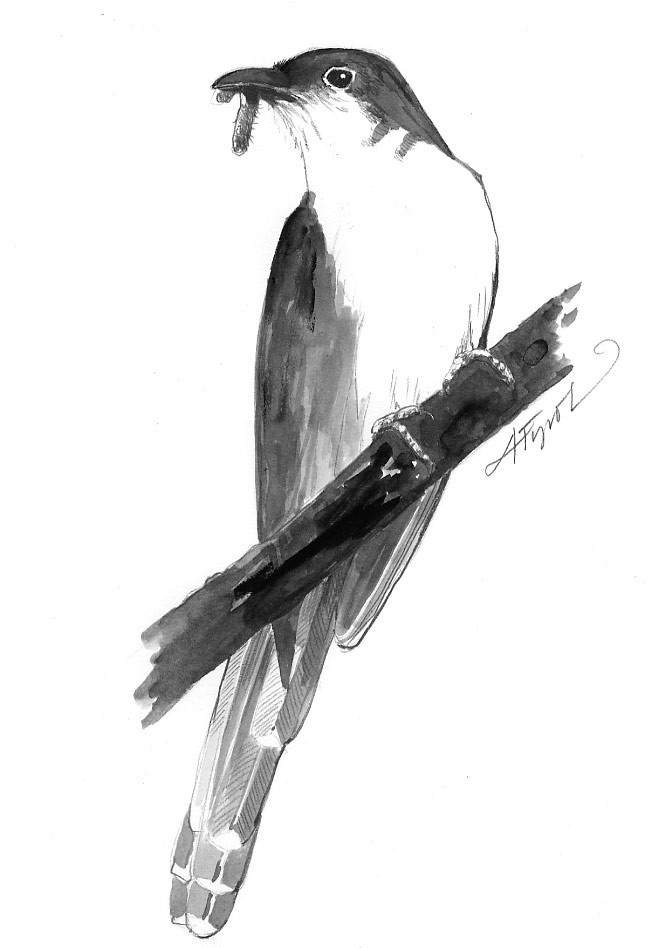
This is the caterpillar summer of our discontent. They seem to be everywhere, eating the leaves off ornamental apple and cherry trees, defoliating black cherry trees in fencelines, and even munching their way across whole hillsides of sugar maples. But our nightmare of writhing critters is the stuff of dreams for black-billed cuckoos, which have been arriving in large numbers this summer to feast on their favorite foodstuff, the tent caterpillar.
Our local relative of the European species of cuckoo-clock fame, and of the road-runner that lives in the desert Southwest, is often heard but rarely seen. The black-billed cuckoo is nearly a foot long with brownish, olive-colored feathers tinged with bronze along the top of its head and back. It is off-white underneath from the black beak down to the tail.
The song (“coo-coo-coo, coo-coo-coo, coo-coo-coo”) reminds me of the lugubrious notes of the mourning dove, only sung in quick, succeeding triplets and with a hard “c” in front of each note.
Black-billed cuckoos have been more common than usual in much of Vermont and New Hampshire during the past two years, a time when many forests are being denuded by ravenous hordes of larvae. Cuckoos possess a ready appetite for caterpillars, and they appear in great numbers during years when there is an outbreak of the bristle-coated buggers, be it the eastern tent caterpillars of early summer, the forest tent caterpillars of midsummer, or the fall webworms of late summer. (We’re two out of three so far this year.)
The bodies of these caterpillars, and that of the fall webworm, are lepidopteran versions of a fuzzy peach, and most birds prefer their larvae hairless, thank you. The stiff hairs build up and cause discomfort in the stomach linings of birds that eat them. Birds that are known to feed on the occasional caterpillar include the rufous-sided towhee, brown thrasher, gray catbird, American crow, and ring-necked pheasant. Ground-feeding American robins and common flickers may also partake. Northern orioles sometimes eat the soft innards and leave the hairy skin behind.
But cuckoos are true dietary specialists adapted to eating the hirsute larvae whose multitudes have overrun our parks and woodlands in many places. Over time, a cuckoo’s stomach becomes matted with caterpillar hairs that stick in the lining. Eventually this felt becomes so dense that it inhibits digestion, so the cuckoo sheds its whole stomach lining and grows it anew.
During a caterpillar population boom, like the one we are having now, caterpillars can account for two-thirds of a cuckoo’s diet. Some studies have found more than 100 caterpillars at a time in cuckoos’ stomachs, with one black-billed cuckoo weighing in with 250 young tent caterpillars in its gut. Another individual was seen devouring three dozen caterpillars in five minutes. Cuckoos will also eat berries, beetles, crickets, grasshoppers, aquatic insects, small fish, and even the eggs and young of other birds.
Since many cuckoos are foraging in our forests, hedgerows, orchards, and overgrown pastures this year, now is an ideal time to seek out the nests of these retiring birds. If you see a cuckoo, watch it and try to discover where it is flying to tend its young, a task that is shared by both sexes. I recently discovered an active black-billed cuckoo nest snuggled close to the main trunk of a Norway spruce, about 15 feet off the ground.
Nests are usually built in a dense shrub or where a branch grows horizontally from a tree trunk, from 2 to 20 feet up. A base of twigs is woven and lined with dry leaves, pine needles, catkins, and the cottony puffs of seeds. Eggs are a solid, dull greenish-blue and a bit more than an inch long. Two to four eggs are laid in the nest, and they hatch in about two weeks. More eggs are laid during years when caterpillars are abundant, helping the cuckoo population increase during caterpillar outbreaks.
Eggs of black-billed cuckoos have also been discovered in the nests of other birds, including those of the cardinal, chipping sparrow, wood thrush, cedar waxwing, eastern wood-pewee, yellow warbler, gray catbird, and even the yellow-billed cuckoo.
If you get too close to a cuckoo nest, you may provoke a territorial display during which the tail is fanned and wings are spread wide, evoking a feathered cape. Fledgling chicks have been known to go limp and play dead if threatened.
When you are out on your cuculiform (“having to do with cuckoos”) quests, be sure to don a cucullate (“hood-like”) cap, or the constant rain of caterpillar castings might cause you to cuss. And if the cuckoos are vocalizing more than usual, you may want to bring a raincoat as well: the calls of these “rain crows” are rumored to be most frequent just before a storm.

